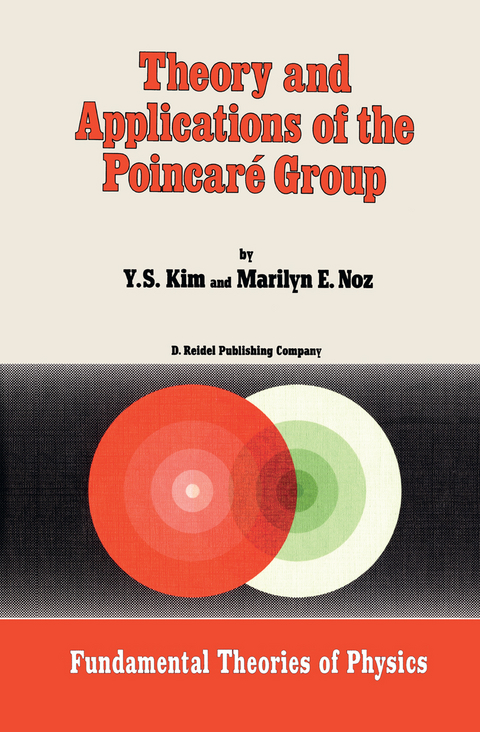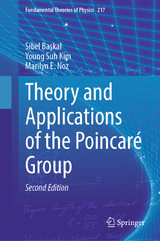
Theory and Applications of the Poincaré Group
Springer (Verlag)
978-94-010-8526-7 (ISBN)
- Lieferbar
- Versandkostenfrei
- Auch auf Rechnung
- Artikel merken
I: Elements of Group Theory.- 1. Definition of a Group.- 2. Subgroups, Cosets, and Invariant Subgroups.- 3. Equivalence Classes, Orbits, and Little Groups.- 4. Representations and Representation Spaces.- 5. Properties of Matrices.- 6. Schur’s Lemma.- 7. Exercises and Problems.- II: Lie Groups and Lie Algebras.- 1. Basic Concepts of Lie Groups.- 2. Basic Theorems Concerning Lie Groups.- 3. Properties of Lie Algebras.- 4. Properties of Lie Groups.- 5. Further Theorems of Lie Groups.- 6. Exercises and Problems.- III: Theory of the Poincaré Group.- 1. Group of Lorentz Transformations.- 2. Orbits and Little Groups of the Proper Lorentz Group.- 3. Representations of the Poincaré Group.- 4. Lorentz Transformations of Wave Functions.- 5. Lorentz Transformations of Free Fields.- 6. Discrete Symmetry Operations.- 7. Exercises and Problems.- IV: Theory of Spinors.- 1. SL(2, c) as the Covering Group of the Lorentz Group.- 2. Subgroups of SL(2, c).- 3. SU (2).- 4. 5L(2, c) Spinors and Four-Vectors.- 5. Symmetries of the Dirac Equation.- 6. Exercises and Problems.- V: Covariant Harmonic Oscillator Formalism.- 1. Covariant Harmonic Oscillator Differential Equations.- 2. Normalizable Solutions of the Relativistic Oscillator Equation.- 3. Irreducible Unitary Representations of the Poincaré Group.- 4. Transformation Properties of Harmonic Oscillator Wave Functions.- 5. Harmonic Oscillators in the Four-Dimensional Euclidean Space.- 6. Moving O(4) Coordinate System.- 7. Exercises and Problems.- VI: Dirac’s Form of Relativistic Quantum Mechanics.- 1. C-Number Time-Energy Uncertainty Relation.- 2. Dirac’s Form of Relativistic Theory of “Atom ”.- 3. Dirac’s Light-Cone Coordinate System.- 4. Harmonic Oscillators in the Light-Cone Coordinate System.- 5. Lorentz-InvariantUncertainty Relations.- 6. Exercises and Problems.- VII: Massless Particles.- 1. What is the E(2) Group?.- 2. E(2)-like Little Group for Photons.- 3. Transformation Properties of Photon Polarization Vectors.- 4. Unitary Transformation of Photon Polarization Vectors.- 5. Massless Particles with Spin 1/2.- 6. Harmonic Oscillator Wave Functions for Massless Composite Particles.- 7. Exercises and Problems.- VIII: Group Contractions.- 1. SE(2) Group as a Contraction of SO(3).- 2. E(2)-like Little Group as an Infinite-momentum/zero-mass Limit of the O(3)-like Little Group for Massive Particles.- 3. Large-momentum/zero-mass Limit of the Dirac Equation.- 4. Finite-dimensional Non-unitary Representations of the SE(2) Group.- 5. Polarization Vectors for Massless Particles with Integer Spin.- 6. Lorentz and Galilei Transformations.- 7. Group Contractions and Unitary Representations of SE(2).- 8. Exercises and Problems.- IX: SO(2, 1) and SU(1, 1).- 1. Geometry of SL(2, r) and Sp(2).- 2. Finite-dimensional Representations of SO(2, 1).- 3. Complex Angular Momentum.- 4. Unitary Representations of SU(1, 1).- 5. Exercises and Problems.- X: Homogeneous Lorentz Group.- 1. Statement of the Problem.- 2. Finite-dimensional Representations of the Homogeneous Lorentz Group.- 3. Transformation Properties of Electric and Magnetic Fields.- 4. Pseudo-unitary Representations for Dirac Spinors.- 5. Harmonic Oscillator Wave Functions in the Lorentz Coordinate System.- 6. Further Properties of the Homogeneous Lorentz Group.- 7. Concluding Remarks.- XI: Hadronic Mass Spectra.- 1. Quark Model.- 2. Three-particle Symmetry Classifications According to the Method of Dirac.- 3. Construction of Symmetrized Wave Functions.- 4. Symmetrized Products of Symmetrized Wave Functions.- 5. Spin Wave Functions for the Three-Quark System.- 6. Three-quark Unitary Spin and SU(6) Wave Functions.- 7. Three-body Spatial Wave Functions.- 8. Totally Symmetric Baryonic Wave Functions.- 9. Baryonic Mass Spectra.- 10. Mesons.- 11. Exercises and Problems.- XII: Lorentz-Dirac Deformation in High-Energy Physics.- 1. Lorentz-Dirac Deformation of Hadronic Wave Functions.- 2. Form Factors of Nucléons.- 3. Calculation of the Form Factors.- 4. Scaling Phenomenon and the Parton Picture.- 5. Covariant Harmonic Oscillators and the Parton Picture.- 6. Calculation of the Parton Distribution Function for the Proton.- 7. Jet Phenomenon.- 8. Exercises and Problems.- References.
| Reihe/Serie | Fundamental Theories of Physics ; 17 |
|---|---|
| Zusatzinfo | XV, 331 p. |
| Verlagsort | Dordrecht |
| Sprache | englisch |
| Maße | 155 x 235 mm |
| Themenwelt | Mathematik / Informatik ► Mathematik ► Algebra |
| Naturwissenschaften ► Physik / Astronomie ► Allgemeines / Lexika | |
| Naturwissenschaften ► Physik / Astronomie ► Theoretische Physik | |
| ISBN-10 | 94-010-8526-9 / 9401085269 |
| ISBN-13 | 978-94-010-8526-7 / 9789401085267 |
| Zustand | Neuware |
| Haben Sie eine Frage zum Produkt? |
aus dem Bereich



